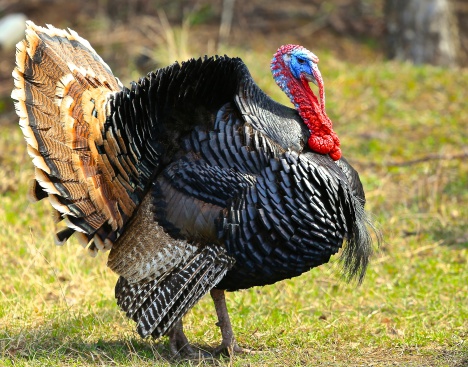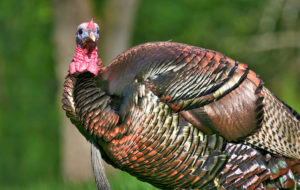
Regulation is all around us – even at Thanksgiving dinner.
The turkey never became the national bird of the United States as Ben Franklin may or may not have advocated – but it has become the centerpiece of a dinner that many American families enjoy today. The turkey is, though, more than just the main entrée appearing on the Thanksgiving dinner table. It has also become, like many other aspects of contemporary society, an object of government regulation.
Under regulations administered by the U.S. Department of Agriculture (USDA), turkeys sold across the United States must comply with a variety of rules designed to protect consumers’ health and safety. For example, the USDA reports, in all its precision, that:
- “All turkeys found in retail stores are either inspected by the USDA or by state systems which have standards equivalent to the federal government. Each turkey and its internal organs are inspected for evidence of disease.”
- “No hormones have been approved for use in turkeys. Antibiotics may be given to prevent disease and increase feed efficiency. In approving drugs for use in livestock and poultry, the Food and Drug Administration (FDA) and Food Safety and Inspection Service (FSIS) work together. FDA sets legal limits for drug residues in meat and poultry. FSIS enforces the limits FDA sets for drug residues.”
- “Additives are not allowed on fresh turkeys … However, if turkeys are ‘processed’ (injected with a basting solution, ground, canned, cured, smoked, dried or made into luncheon meats), additives such as MSG, salt, or sodium erythorbate may be added but must be listed on the label.”
- “Bone-in poultry products that are injected or marinated with a solution containing butter or other edible fat, broth, stock or water plus spices, flavor enhancers and other approved substances must be labeled as ‘basted’ or ‘self-basted.’ The maximum added weight of approximately 3% solution before processing is included in the net weight on the label.”
- “The term ‘fresh’ may only be placed on raw poultry that has never been below 26 °F. Poultry held at 0 °F or below must be labeled ‘frozen’ or ‘previously frozen.’ No specific labeling is required on poultry between 0 and 26 °F.”
- “Turkeys of either sex that are less than 8 months of age according to present regulations are considered ‘young’ turkeys.”
- “FSIS requires safe handling instructions on packages of all raw or partially cooked turkey products (fresh and frozen) packaged and labeled in federally and state inspected plants or in retail stores and sold to consumers.”
- “FSIS requires mandatory nutrition labeling for most multi-ingredient turkey products except the raw, single-ingredient products such as turkey breast.”
In July of this year, the USDA also issued a new set of requirements governing the agency’s inspection of turkey and other poultry processing facilities. In a document spanning more than seventy pages and published in the Federal Register, the USDA purported to “modernize” the way that “turkey slaughtering establishments” and other poultry processors are inspected. Rather than having all inspectors visually observe each and every carcass as it travels along the production line, the new rules, among other things, allow some inspectors to be re-positioned to observe earlier efforts by the producers to sort bird carcasses and remove from production those that would be unsafe to eat.
The USDA spent years developing its new inspection rules. The Secretary of Agriculture, Tom Vilsack, stated that the new approach “imposes stricter requirements on the poultry industry and places our trained inspectors where they can better ensure food is being processed safely. These improvements make use of sound science to modernize food safety procedures and prevent thousands of illnesses each year.”
Of course, like many other important areas of regulation, the USDA’s regulation of turkey and other poultry processing operations has not been without its controversy. Upon completion of the USDA rule in July, for example, the President of the Center for Progressive Reform, Rena Steinzor, called the new rule a “travesty,” arguing that in addition to putting workers at processing facilities at greater risk, the new rule “will pull federal inspectors off the processing line, ensuring that carcasses caked in blood, guts, and feathers whir by at the rate of 2.3 bird per second.”
Even reading the Federal Register at a similarly fast rate reveals several highly detailed passages of the operative language of the USDA’s new rules. These passages show how much a regulatory system can pervade even a seemingly simple custom like what ends up on a holiday dinner table. The new rules for turkey processing facilities include, for example, the following sampling of prescriptions that might marvel guests and family members gathered for dinner today:
- “A minimum of 200 foot-candles of shadow-free lighting with a minimum color rendering index value of 85 must be provided where the birds are inspected to facilitate online carcass inspection.”
- “Hand rinsing facilities must be provided for use by and within easy reach of the online carcass inspector. The hand rinsing facilities must have a continuous flow of water or be capable of being immediately activated and deactivated in a hands-free manner, must minimize any splash effect, and must otherwise operate in a sanitary manner that prevents contamination of carcasses and inspector clothing. The hand rinsing facilities must provide water at a temperature between 65 and 120 degrees Fahrenheit.”
- “A separate clipboard holder for holding recording sheets must be provided for and within easy reach of the online carcass inspector.”
- “At the pre-chill location, the vertical distance from the bottom of the shackles to the floor must not be less than 48 inches.”
Of course, even if the regulations governing turkey processing, in all their glory and fine-print detail, worked perfectly, that still would not guarantee an absence of foodborne illnesses. People can still get sick from pathogens associated with food handling and meal preparation — well after a turkey has left the slaughtering house. The Centers for Disease Control and Prevention (CDC) estimate that nearly 50 million Americans get sick each year from exposure to foodborne pathogens, with nearly 3,000 people dying per year from such illnesses.
Although all of these cases do not stem from the unsafe handling and cooking of food, officials at federal food safety agencies do not rely solely on regulation of processors to try to keep Americans safe from foodborne illnesses. Especially at Thanksgiving time, they also work to provide the public with vital information about how to thaw, cook, and stuff turkeys safely. For example, the USDA’s FSIS has joined forces with the FDA and the CDC to create the website, FoodSafety.gov, which provides easy access to a variety of important food safety tips that anyone needs for preparing a turkey dinner.
Bon appétit – and happy Thanksgiving.



